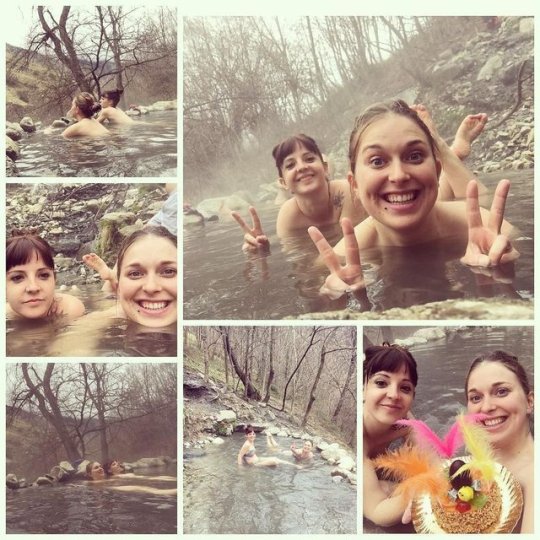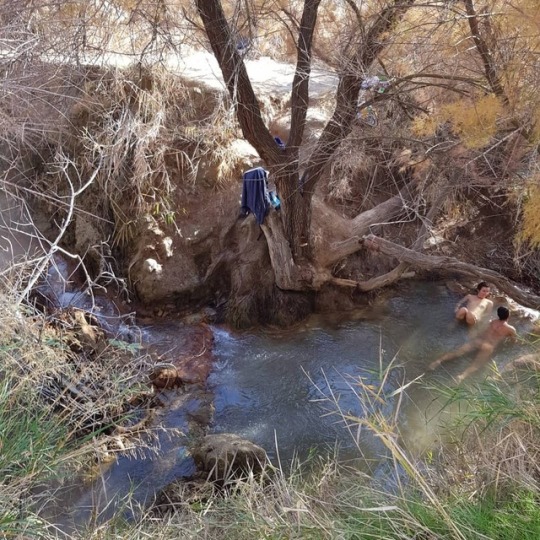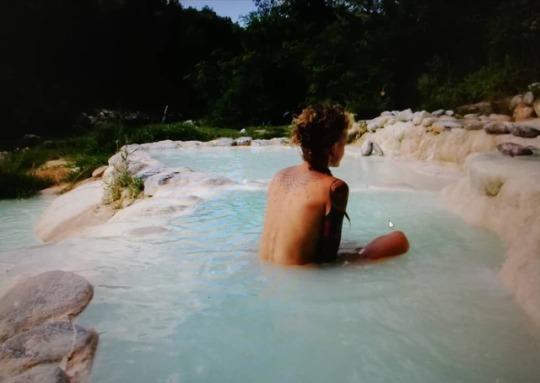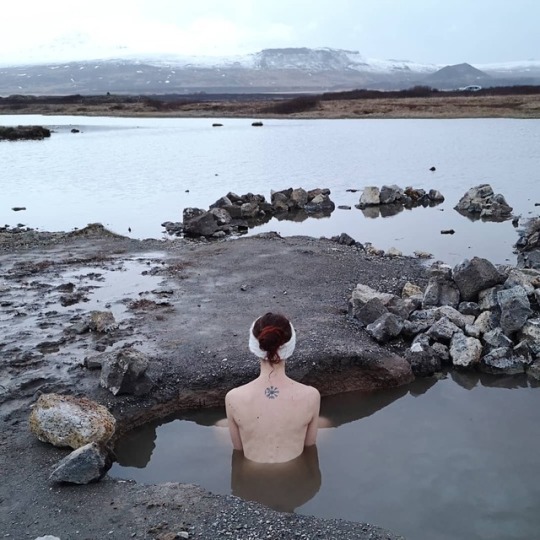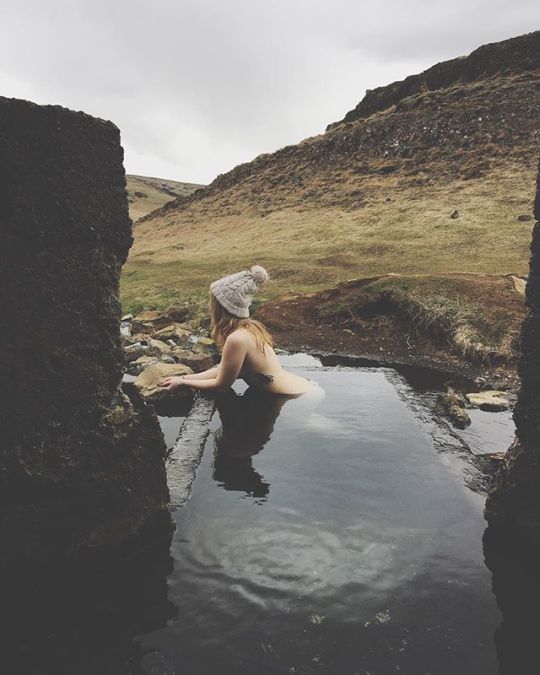We toured the Muga Mountains on an eBike, enjoying a dreamy natural bath. We also enjoyed a tantric massage workshop at our location and participated in an exciting Rogaine. We ate oysters and took a dip in Leucate, explored Sant Martí del Canigó, and relaxed in some hot springs in the Pyrenees. An eBike tour through La Garrotxa rounded out a month full of unique experiences!
Cultureofbathing has a piece (Mar. 15) on wellness and the question:
'Whatever happened to the leisurely bath?
The article looks into the bathing art in/of many (Euro) countries, past and present.
Could it be just doing nothing, that's just a major part of the attraction of soaking?
Be it in hot springs, sauna's, hammam's and assorted. Wherever you are?
So with this we start another overview of Europe's soaking and soaking culture.
France. 23b~log (Jan. 12) heads over to centre of the country's Chaudes Aigues:
'We were visiting in mid January 2025 at the time we had something like -10ºC outside during the night and little more during the day. I just wanted a hot bath at this point and was willing to pay entrance to enter a pool. I know it’s not uncommon for spas to be closed for the cold season: But I will remain baffled, furious and sad. Sacré bleu'.Marks: just 1
Bert, the blogger on 23b~log, then continues further south to explore and report (Jan. 14) on Rennes-les-Bains.
Considering that outside temperatures were freezing, it's not at all surprising that he misses the best bath, simply because the ambient temperature ensures the hot water cools down too much to enjoy. It (Rennes) is still awarded a 6.5:
'The coldest days of the year are not ideal time to bathe here, since the only hot option is quite crowded and not exactly hygienic. I can imagine having a better time in summer when he other sources become warm enough to enjoy'.
In the north of Portugal, not too far from Galicia.
Canalaltotamega (Mar. 20) reports on the new thermal hot spring fed complex opening in Chaves. Unfortunately the artcle is unquoteable.
I looked up the Termas de Chaves website:
'Part of the main Wellbeing area, the Aquae Salutem Complex [Termal Aquae Salutem] features a diverse Hydrothermal Circuit, designed to revitalise both body and mind. Highlights include naturally heated Hydrodynamic Pools, between 30ºC and 36ºC, a Sauna and a Turkish Bath — ideal for purification and detoxification. The Sensory Showers, complete with sound effects and thermal contrasts, including an Ice Fountain, stimulate the senses and promote deep relaxation.The space has capacity for up to 104 people. Access permitted for children aged 14 and over when accompanied by an adult.Visit the Aquae Salutem Complex — the only one of its kind in Portugal — and discover a place where history, innovation and wellbeing come together in perfect harmony'.
Portugal News (Mar. 26) though does the news and in English:
'The center's new features include the Hydrodynamic Pools, which operate outdoors and are fed by naturally hot waters, at 76 degrees, which enhance the therapeutic benefits of this natural resource....The complex has capacity for 104 people. It is the result of a total investment of 2.4 million euros, financed by the Northern Regional Operational Programme, and is integrated into the existing Termas de Chaves. The new space was built through the refurbishment of part of the old building, which also received new relaxation areas, service desks and changing rooms'.
Pounded
From 2 years back (8 Jan. 2023), adventurediary headed over to Tuscany for a wintery soak / adventure:
'After breakfast was a short drive to the first of two natural hot-springs we would visit in succession. Bagni San Fillipo is a series of hillside pools surrounded by forest. Its mostly visited by locals for its so called healing properties and flies a little under the radar. At this time of year it was very quiet and we were able to enjoy one pool just to ourselves. It was quite wet and dirty getting to the pools but once in, the water was nearly 40°C and very difficult to get out of again! After a couple of lovely hours there we reluctantly dragged ourselves away and made the drive through the countryside to our next overnight stop at Saturnia.SaturniaSaturnia is a spa town which has been inhabited, as most towns in this region have, since ancient times. Its most famous for its sulphurous hot-spring pools which cascade at the side of an abandoned mill. These pools hold water at around 37°C and are formed by the deposition of calcareous rock from the evaporation of the water under the gushing waterfall. Its really a spectacular sight and a joy to just lie in for much longer than is probably recommended!The van park was quite dilapidated with very uneven access, a sanitary area that really needs an upgrade and a camper service that needed to be condemned. But it served a purpose even at a high price and as it was the only park-up within reasonable walking distance.Arriving late in the afternoon we went immediately to the pools and were a little surprised to find it completely full. It’s an incredible natural phenomenon and still free to access so it has continuous traffic through the day. And although we enjoyed it, there were far too many people for us so we went back to the van and enjoyed a sunset meal and an early night.The next morning we were already back at the pools before sunrise which seemed to be the perfect time for us as there were only 2 other people there for the next 60 minutes. We enjoyed a wonderful time jumping between the pools and being pounded by the waterfalls. We were already making our way back for breakfast and smelling of sulphur before the masses had even opened their eyes.
The Guardian (Mar. 21) with an interesting article on Napoli's possible next point of increasing volcanic activity:
'Photojournalist Alessandro Gandolfi has been documenting the Phlegraean Fields in southern Italy, where a record 6,740 earthquakes were recorded in 2024, and the seismic swarm has continued in 2025. The volcanic field has been active for more than 80,000 years. It is dotted with craters, lakes and fumaroles as well as roads, factories and the homes of more than 600,000 people....Bradyseism, literally “slow movement”, continues to raise the ground across the Phlegraean Fields. It raised Pozzuoli by two metres in the 1980s, leading to the evacuation of 40,000 people from the Rione Terra neighbourhood.Bradyseism has always existed in these parts. On the Roman columns of the Temple of Serapis you can still see the holes made by stone-eroding organisms, created when the ground subsided about 10 metres in the following centuries. For a long time they were submerged in sea water.Two women enter the swimming pool at the Terme Vesuviana spa in Naples. The mineral springs connected to Vesuvius have been exploited for their health benefits since Roman times. Photograph Alessandro Gandolfi
Baden (Switzerland) Bad zum Raben bath cooperation has announced the hot spring fed baths are now closed, subject to renovation.
Until 2026? 2027 even, according to the Badener Tageblatt (Jan. 21).
More details on the changes, likewise published by the Badener Tageblatt (Feb. 12).
Wrapping up the hot springs, another slightly older share (Jan. 29, 2024):
The sauna world. From all over Europe. No better way to start than in Finland.
New York Times (Mar. 4) looks at the sauna and questions 'Can a Finnish Sauna Improve Society?
Despite the implications of a positive answer on this, it's just a teaser for a look into the architectural significance of Finnish sauna design:
'Finland now has a social welfare system that rivals those of its Scandinavian neighbors, and about three million saunas for its population of 5.6 million people. In these spaces — from tiny lakeside cabins to semipublic spas in city centers — “it doesn’t matter how much money you have or what you do,” says Saija Silen, a 48-year-old curator at the Museum of Central Finland in the city of Jyväskylä. “The sauna is the foundation of Finnish equality.”
The article then looks at the build of a sauna (the architects), changes of society (from public to private and back again (?)) and how sauna culture is Finnish culture. And vice-versa.
Arguably, we could also have started this section with Estonia.
Nowness has a vdo on what they describe as the Mooska (Oct. 18, 2024) ritual. If you liked the Smoke Sauna Sisterhood, head here now. Description:
'In Haanja, Estonia, the Võromaa smoke sauna tradition is observed as a unique path to emotional and physical wellness – a profound healing ritual, continued by the region’s rural community. Honored by the UNESCO List of Intangible Cultural Heritage for its importance to Estonian culture, the practice initiates a transformative journey for those who enter into it, rooted in ancient practice and integrating knowledge of local herbology in a spiritual, sonic experience.From the verdant surroundings of Mooska farm, Eda Veeroja has become renowned for her sauna healing capabilities, documented in short [12 min.] film Mooska. Directed by Samuel Aarnio, the immersive documentary ventures deep into the ritual, as Veeroja constructs a sacred space between women seeking to clear a friend’s relationship trauma'.
An article from UK's Daily Mail (Mar 11), with a report on a visit to a typical Dutch 'spa'. But this being the sensationalist press, of course the emphasis is on the lack of clothing. The author though is out to promote the clothelessness as neutral as possible; him being a British Naturism promoter:
'The spas are not ‘naturist’ places - the nudity is simply a means to an end.The most effective way (the only way?) to get the right results from bothering to have a sauna in the first place is to allow it to affect the whole of your body.You wouldn’t have a bath with your underwear on.In practice - especially in February, when I visited - most guests wander around in their dressing gowns, only disrobing (literally) when they enter a sauna or pool.What really sets these places apart from the UK experience is the sheer number of facilities.The buildings themselves are not necessarily huge, nor need to be surrounded by manicured lawns, topiary hedges or classical statuary to attract clients.They’re everywhere too and, it seems to me, treated by locals as we would a leisure centre or gym.They’re packed - not to uncomfortable levels—but I mean popular. And to all age groups. Though it has to be said, in my late fifties, I’m often one of the older people spa-ing'.
The answer:'They all have the same logo as they are or were associated with Josef Wund, I loved Therme Erding, so was wondering what one is the second best to try? I know the Vabali ones, but I really liked the format of Therme Erding so want to try similar places.Therme Bad WörishofenBadeparadies Schwarzwald TitiseeThermen & Badewelt SinsheimThermen & Badewelt EuskirchenI also noticed another place called Obermain Therme has a similar logo, but I don't think it is related'.
The ranking checked 300 thermen throughout Austria, Germany and Switzerland.'Here's a ranked list of the top 100 Thermes in Germany for 2024 https://www.travelcircus.de/thermenurlaubTherme Erding is #1 Therme Euskirchen is #2 Therme Sinshiem is #3 Therme Bad Wörishofen is #6 Obermain Therme is #8 and Badeparadies Schwarzwald is way down at #29 The three Vabali Thermes show up at #4, 7 & 15As for ownership, Therme Erding is operated by the Global Therme Group. Euskirchen, Sinsheim and Schwarzwald are operated by a Therme Group subsidiary, Thermengruppe Josef Wund.Therme Bad Wörishofen is not connected to the Therme group, but Jörg Wund is their managing director. There's probably an interesting family story about why he's using the Therme Group logo.Obermain Therme appears to have no relation to the others'.

Marvel
Saunachannel advises (Mar. 12) all followers to head over to their site and visit their latest offering: Caucasian Healing Waters: Bathing in Georgia.
A really beautiful shot and authentic overview of what's available in the country, concerning hot springs (most), wellness and sauna's. If you have 20 minutes to spare, it's really worthwhile.
Their description:
'Experience a transformative journey through the heart of Georgia, where ancient traditions and natural wonders converge in the healing embrace of its waters. Healing Caucasian Waters: Bathing in Georgia unveils the hidden sanctuaries and therapeutic rituals that have shaped the culture of this captivating land for centuries. From the mineral-rich mud of Akhtala to the steamy sulfur baths of Tbilisi and the serene natural springs nestled in remote landscapes, this film invites you to immerse yourself in the restorative power of Georgia's diverse thermal experiences. Discover the stories, the sensations, and the profound sense of well-being that these sacred waters offer, and witness how they continue to nurture both body and soul.1. Horizons Kakheti, Republic of Georgia...2. Akhtala - Mud Treatment ResortAkhtala is a sanctuary of therapeutic mud, a geological marvel where mineral-rich mud has been used for centuries to alleviate ailments. This resort harnesses the earth's ancient power, offering treatments that soothe and revitalize. The experience is deeply grounding, a return to primal healing, where the very earth itself becomes a source of restoration. The mineral properties of the mud are known to help with many physical ailments....3. Tbilisi Sulfur Baths - Banya №5...4. Tbilisi Balneological ResortThe Tbilisi Balneological Resort is a modern haven dedicated to the science of healing waters. Here, advanced techniques blend with natural springs to offer a comprehensive approach to wellness. From mineral baths to specialized shower and underwater therapies, the resort provides a structured path to recovery and revitalization. It's a place where the therapeutic power of Georgia's waters is harnessed with precision and care to include massage with a bath attendant similar to a Turkish Hammam treatment complete with a kisa scrub and cleansing, followed by relaxation and finishing off with tea.5. Vani Sulfur Pool (4H3P+RQ5, Дихашхо, Vani)Hidden away in the countryside near Vani, this natural sulfur pool offers an unadulterated experience of Georgia's thermal bounty. The rustic setting, far from the city's bustle, allows for a truly immersive encounter with the healing waters. Here, nature dictates the pace, and the simple act of bathing becomes a profound connection to the earth's restorative energy. The open air setting allows for a very natural bathing experience.6. Tskaltubo (8JG2+HRR, Tskaltubo)Tskaltubo is synonymous with radon-carbonate mineral waters, a legacy that has drawn visitors seeking healing for decades. The unique properties of these waters, naturally warm and rich in minerals, offer a gentle yet powerful therapeutic experience. The grand, somewhat faded elegance of Tskaltubo's sanatoriums speaks to a time when this town was a premier destination for health and wellness. The waters are known to help with circulatory and nervous system conditions.7. Tekhuri Thermal Springs (958W+33J, Jikha)Deep in the lush landscapes surrounding Jikha, the Tekhuri Thermal Springs offer a raw and untamed experience of Georgia's geothermal wonders. These natural springs, located in the riverbed of Abasha River provide a pure and unadulterated connection to the earth's warmth. The mineral water contains sulfur, calcium, magnesium, and silicon which is a testament to the healing power of these natural springs.As the steam clears and the waters settle, Healing Caucasian Waters: Bathing in Georgia leaves you with a lasting sense of tranquility and a deep appreciation for the enduring connection between humanity and nature. Our film is an invitation to experience the transformative power of Georgia's healing waters for yourself. Whether you seek physical rejuvenation, cultural immersion, or simply a moment of serene escape, these ancient traditions offer a profound path to wellness. We hope this journey inspires you to explore the hidden spas and natural springs of Georgia, and to discover your own path to healing in the heart of the Caucasus.
Arguably Belgium's no. 1 thermal resort, Thermen Katara, has announced (Mar. 21) for the Easter period two additional suits-only days. The announcement on Facebook, seems to ellict astonishment.
Read this comment from Apr. 9 (translated):'Today we went to swimsuit day..Honestly, a completely different audience, no real sauna goers, lots of noise, children, no peace, I would like to know when there are NOT many people, Sunday morning at 8 o'clock? And where did the scrub salt go? Or does that not work with those swimsuits??A: apparently it stains swimwear, so yes it doesn't work with swimsuits.
4wMercii bubikon!!@kantonzürich @mo.prax @domenico_decoco @quirin_streuli @keramikzentrale @cilio_planet @linmidara @tommasuki @albalmaseda @brunnengehn @ritterhausbubikon#brunnengehn #hallowasser #hotpot #brunnen #wasser #pumpen #velo #anhängerkupplung #publicspace
Finally, the Swiss initiative Brunnen Gehn has spent most of March touring smaller places in the Kanton Zürich (see photo above). Translated:
'The project dream comes true: "Going to the Fountains" tours villages, hamlets, towns, and the metropolitan area. With the "Going to the Fountains" tour through the canton of Zurich , we will travel through the canton from March 14 to April 1, inviting ourselves to ten towns and villages to heat the fountains and, in turn, invite the locals to join the bathing ritual in the evening. The "Going to the Fountains" project has existed in Basel since 2016. Every year from November to March, around 15 fountain heaters heat ten Basel fountains to a pleasant 39°C using a mobile wood-burning stove. In doing so, they revitalize the neighborhoods and transform public spaces into attractive meeting places, even in winter. A reception desk, mobile cloakroom, cold shower, footbath, and lifeguard complete the " Going to the Fountains" ritual'.
Bei der Kälte sind heiße Quellen einfach herrlich.Wir sind wieder mit Michl und Yvonne zusammen und werden auch gemeinsam Richtung Türkei fahren.#thermophylae #heißequellen #gemeinsamreisen


.jpeg)




